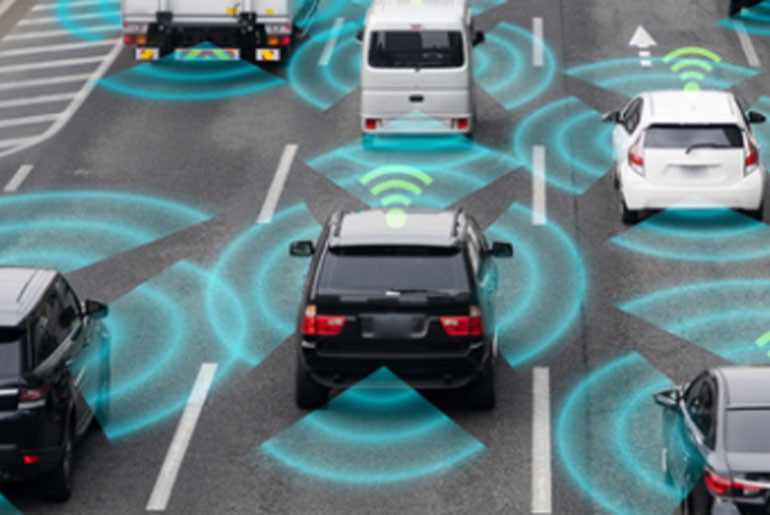Automotive radars are vehicle sensors that use radio waves to detect the positions and trajectories of objects around them, such as other vehicles, animals, and people. They are a key technology for modern cars, enabling intelligent and autonomous features.
Automotive radars operate in the millimetre range, meaning the wavelength of the transmit signal is a few millimetres. They consist of a transmitter and receiver, which determine the object’s distance, speed, and direction. The transmitter sends radio waves that hit an object and bounce back to the receiver. The time it takes for the pulse to return allows the computer to calculate the other vehicle’s speed and direction. Automotive radars have multiple transmit and receive channels, which are used to drive different antennas and give angular information about the object.
Radar is handy for automotive applications because vehicles are good reflectors of electromagnetic waves. Automotive radars are critical sensor systems in autonomous driving assistance systems (ADAS), one of several sensor systems for collision avoidance and pedestrian and cyclist detection.
Radar modules are a standard feature in modern vehicles, and the automotive radar market is the fastest-growing segment of the radar market.
How do automotive radars work to detect objects and obstacles?
At a high level, a radio wave is broadcast and reflected by an object, and the location and motion are measured using the following principles:
Distance measurement: The time difference between transmitted and reflected signals is proportional to distance.
Velocity measurement: Due to the Doppler effect, an approaching object produces a reflected wave with a slightly higher frequency than the transmitted wave, and a retreating object produces a somewhat lower frequency. The frequency offset is proportional to the object’s relative velocity.
Bearing measurement: The direction of an item is determined by employing an array of antennas and studying the characteristics of the reflected wave that strikes each of them.
How Automotive Radars Are Advancing Safety Features?
Automotive radars play a crucial role in advancing safety features in modern vehicles, utilizing radar technology to detect objects, pedestrians, and vehicles around the car. Here’s how automotive radars are contributing to enhanced safety:
Collision Avoidance Systems:
- Radar-based collision avoidance systems can detect objects in the vehicle’s path and automatically apply the brakes or alert the driver to prevent accidents.
- These systems work by continuously scanning the surroundings and assessing potential collision risks, providing early warnings to the driver.
Adaptive Cruise Control (ACC):
- ACC systems use radar sensors to maintain a safe distance from vehicles ahead by automatically adjusting the vehicle’s speed.
- Radar sensors monitor vehicles’ distance and relative speed in the same lane, allowing the car to accelerate or decelerate accordingly.
Blind Spot Detection:
- Radar sensors placed on the sides of the vehicle can detect vehicles in blind spots, warning the driver through visual or auditory alerts.
- This feature enhances driver awareness and helps prevent accidents caused by lane changes when another vehicle is nearby.
Cross-Traffic Alert:
- Radar sensors can detect vehicles approaching from the sides when backing out parking spaces or driveways.
- Cross-traffic alert systems warn drivers to prevent collisions with vehicles that may not be visible through the rearview mirrors.
Lane Departure Warning (LDW):
- Radar technology is integrated with LDW systems to monitor lane markings and detect unintentional lane departures.
- When the vehicle drifts out of its lane without signalling, the system alerts the driver to take corrective action, reducing the risk of accidents caused by lane drifting.
Pedestrian Detection:
- Automotive radars can detect pedestrians near the vehicle, even in low visibility conditions like darkness or inclement weather.
- Pedestrian detection systems provide warnings or automatically apply the brakes to avoid collisions with pedestrians, enhancing pedestrian safety.
Intersection Assistance:
- Radar sensors combined with advanced algorithms can provide intersection assistance by detecting vehicles approaching from different directions.
- This feature can help prevent accidents at intersections by alerting drivers of potential collisions or automatically applying brakes if necessary.
Emergency Brake Assist:
- Radar-based emergency brake assist systems can detect imminent collisions and assist the driver in applying maximum braking force to mitigate the impact or avoid the collision altogether.
- These systems work with other safety features, like collision avoidance systems, to enhance overall vehicle safety.
Conclusion
In summary, automotive radars are instrumental in advancing safety by detecting potential hazards early, enabling proactive measures to prevent accidents, and enhancing driver awareness and response capabilities. As radar technology continues to evolve, it is expected to play an even more significant role in improving road safety and reducing the number of accidents on the roads.

